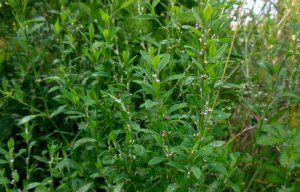Description: Knotweed, scientifically known as Polygonum aviculare, is an annual herbaceous plant belonging to the Polygonaceae family. Also referred to as Bird's Knotweed or Knotgrass, this plant is widespread and commonly found in various habitats, including lawns, gardens, and disturbed areas. It is recognized for its prostrate growth habit and small, inconspicuous flowers.
Habitat and Distribution: Knotweed is adaptable to a variety of environments and can thrive in open fields, gardens, lawns, and along roadsides. Native to Europe, it has become naturalized in North America and other regions. Knotweed often establishes itself in compacted or disturbed soils.
Physical Features:
- Stems and Leaves: Knotweed produces prostrate or ascending stems with alternate leaves. The leaves are lance-shaped and have a pointed tip.
- Flowers: The tiny flowers of Knotweed are greenish to pinkish and are arranged in compact clusters along the stems. The flowers lack showy petals and may go unnoticed.
Ecological Impact:
Knotweed can have both positive and negative ecological impacts:
- Erosion Control: The prostrate growth habit of Knotweed helps stabilize soils, contributing to erosion control.
- Weed Competitor: Knotweed can be competitive in cultivated areas, potentially outcompeting desirable plants.
Concerns and Challenges:
- Invasive Nature: Knotweed's ability to spread rapidly and establish itself in various environments makes it a common weed, especially in lawns and gardens.
Control and Management:
Cultural Practices:
- Lawn Maintenance: Regular mowing and maintaining a healthy lawn can help suppress the growth of Knotweed. Mowing can prevent the development of flowers and seeds.
- Soil Improvement: Addressing soil compaction and improving soil fertility can create conditions less favorable for Knotweed.
Mechanical Control:
- Hand Pulling: Hand pulling Knotweed is effective for small infestations. Be sure to remove the entire plant, including the root system.
- Regular Cutting: Consistently cutting or trimming Knotweed can weaken the plants and prevent seed production.
Chemical Control:
- Herbicides: Selective herbicides labeled for broadleaf weed control can be used to target Knotweed. Carefully follow application instructions to avoid harm to desirable plants.
Preventing Spread:
- Early Detection: Regularly inspecting lawns, gardens, and cultivated areas for signs of Knotweed is crucial for early detection. Prompt removal or control measures can prevent its spread.
- Minimizing Soil Disturbance: Minimizing soil disturbance during gardening or landscaping activities can help reduce the germination of Knotweed seeds and prevent the spread of the plant.
- Promoting Desired Vegetation: Encouraging the growth of desirable plants in lawns and landscapes can help outcompete Knotweed and limit its establishment.
In conclusion, managing Knotweed requires a combination of cultural practices, mechanical removal, and, if necessary, the use of selective herbicides. Early detection and proactive measures are essential to prevent the aggressive spread of Knotweed and maintain the desired vegetation in lawns, gardens, and other cultivated areas.



